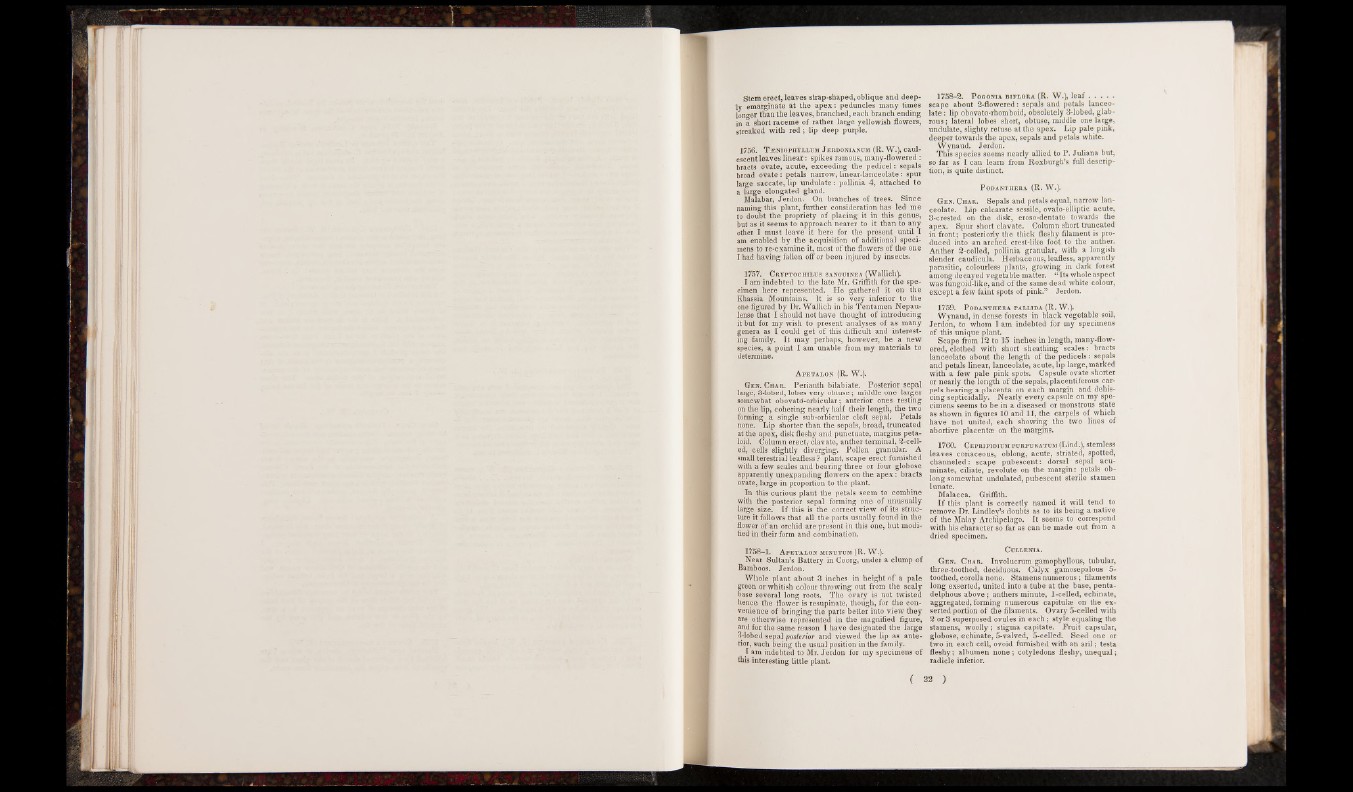
Stem erect, leaves strap-shaped, oblique and deeply
emarginate at the ap ex : peduncles many times
longer than the leaves, branched, each branch ending
in a short raceme of rather large yellowish flowers,
streaked with re d ; lip deep purple.
1756. T jeniophyllum J erdonianum (R. W.), caulescent
leaves linear: spikes ramous, many-flowered:
bracts ovate, acute, exceeding the pedicel: sepals
broad ovate: petals narrow, linear-lanceolate: spur
large saccate, lip undulate: pollinia 4, attached to
a large elongated gland.
Malabar, jerdon. On branches of trees. Since
naming this plant, further consideration has led me
to doubt the propriety of placing it in this genus,
but as it seems to approach nearer to it than to any
other I must leave it here for the present until I
am enabled by the acquisition of additional specimens
to re-examine it, most of the flowers of the one
I had having fallen off or been injured by insects.
1757. Cryptochilus sanguine a (Wallich).
I am indebted to the late Mr. Griffith for tne specimen
here represented. He gathered it on the
Khassia Mountains. It is so very inferior to the
one figured by Dr. Wallich in his Tentamen Nepau-
lense that I should not have thought of introducing
it but for my wish to present analyses of as many
genera as I could get of this difficult and interesting
family. It may perhaps, however, be a new
species, a point I am unable from my materials to
determine.
Apetalon (R. W.).
Gen. Char. Perianth bilabiate. Posterior sepal
large, 3-lobed, lobes very obtuse; middle one larger
somewhat obovatd-orbicular; anterior ones resting
on the lip, cohering nearly half their length, the two
forming a single sub-orbicular cleft sepal. Petals
none. Lip shorter than the sepals, broad, truncated
at the apex, disk fleshy and punctuate, margins peta-
loid. Column erect/ clavate, anther terminal, 2-cell-
ed, cells slightly diverging. Pollen granular. A
small terestrial leafless ? plant, scape erect furnished
with a few scales and bearing three or four globose
apparently unexpanding flowers on the apex: bracts
ovate, large in proportion to the plant.
In this curious plant the petals seem to combine
with the posterior sepal forming one of unusually
large size. If this is the correct view of its structure
it follows that all the parts usually found in the
flower of an orchid are present in this one, but modified
in their form and combination.
1758-1. Apetalon minutum (R. W.).
Near Sultan’s Battery in Coorg, under a clump of
Bamboos. Jerdon.
Whole plant about 3 inches in height of a pale
green or whitish colour throwing out from the scaly
base several long roots. The ovary is not twisted
hence the flower is resupinate, though, for the convenience
of bringing the parts better into view they
are otherwise represented in the magnified figure,
and for the same reason I have designated the large
3-lobed sepal posterior and viewed the lip as anterior,
such being the usual position in the family.
I am indebted to Mr. Jerdon for my specimens of
this interesting little plant.
1758-2. P ogonia b if lo r a (R. W.), l e a f ............
scape about 2-flowered: sepals and petals lanceolate:
lip obovato-rhomboid, obsoletely 3-lobed, glabrous;
lateral lobes short, obtuse, middle one large,
undulate, slighty retuse at the apex. Lip pale pink,
deeper towards the apex, sepals and petals white.
Wynaud. Jerdon.
This species seems nearly allied to P. Juliana but;
so far as I can leam from Roxburgh’s full description,
is quite distinct.
P oDANTHERA (R. W.).
Gen. Char. Sepals and petals equal, narrow lanceolate.
Lip calcarate sessile, ovato-elliptic acute,
3-crested on the disk, eroso-dentate towards the
apex. Spur short clavate. Column short truncated
in front; posteriorly the thick fleshy filament is produced
into an arched crest-like foot to the anther.
Anther 2-celled, pollinia granular, with a longish
slender caudicula. Herbaceous, leafless, apparently
parasitic, colourless plants, growing in dark forest
among decayed vegetable matter. “ Its whole aspect
was fungoid-like, and of the same dead white colour,
except a few faint spots of pink.” Jerdon.
1759. PoDANTHERA PALLIBA (R. W.).
Wynaud, in dense forests in black vegetable soil,
Jerdon, to whom I am indebted for my specimens
of this unique plant.
Scape from 12 to 15 inches in length, many-flowered,
clothed with short sheathing scales: bracts
lanceolate about the length of the pedicels: sepals
and petals linear, lanceolate, acute, lip large, marked
with a few pale pink spots. Capsule ovate shorter
or nearly the length of the sepals, placentiferous carpels
bearing a placenta on each margin and dehiscing
septicidally. Nearly every capsule on my specimens
seems to be in a diseased or monstrous state
as shown in figures 10 and 11, the carpels of which
have not united, each showing the two lines of
abortive placentae on the margins.
1760. Cepripidium purpuratum (Lind.), stemless
leaves coriaceous, oblong, acute, striated, spotted,
channeled: scape pubescent: dorsal sepal acuminate,
ciliate, revolute on the margin: petals oblong
somewhat undulated, pubescent sterile stamen
lunate.
Malacca. Griffith.
If this plant is correctly named it will tend to
remove Dr. Lindley’s doubts as to its being a native
of the Malay Archipelago. It seems to correspond
with his character so far as can be made out from a
dried specimen.
Cullenia.
Gen. Char. Involucrum gamophyllous, tubular,
three-toothed, deciduous. Calyx gamosepalous 5-
toothed, corolla none. Stamens numerous; filaments
long exserted, united into a tube at the base, penta-
delphous above; anthers minute, 1-celled, echinate,
aggregated, forming numerous capitulae on the exserted
portion of the filaments. Ovary 5-celled with
2 or 3 superposed ovules in e a ch ; style equaling the
stamens, woolly; stigma capitate. Fruit capsular,
globose, echinate, 5-valved, 5-celled. Seed one or
two in each cell, ovoid furnished with an a ril; testa
fleshy; albumen none; cotyledons fleshy, unequal;
radicle inferior.